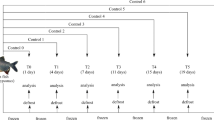Abstract
13C Nuclear magnetic resonance spectroscopy was applied to the study of lipid hydrolysis occurring during industrial canning of tuna (Thunnus alalunga). An increase in the free fatty acid (FFA) level was observed after cooking and sterilization, and a different FFA pattern was found when storage of the frozen raw material and thermal steps (cooking and can sterilization) were compared. Lipolysis in raw muscle occurs preferentially in thesn-1 andsn-3 acyl positions of triacylglycerols, with a consequent cleavage of saturated and monounsaturated fatty acids. After thermal processing, an increase of docosahexaenoic acid (DHA) was found in the FFA fraction, as well as a relative decrease of the peak intensity of DHA in thesn-2 position of triacylglycerols. This finding indicates a different mechanism of FFA release during the frozen storage and thermal processing of raw fish.
Similar content being viewed by others
References
Maclean, J., and C.H. Castell,J. Fish. Res. Board Can. 21:1345 (1964).
Castell, C.H., B.A. Moore, P.M. Jangaard and W.E. Neal,Ibid. 23:1385 (1966).
Dyer, W.J., and M.L. Morton,Ibid. 13:129 (1956).
Hardy, R., and J.G.M. Smith,J. Sci. Food Agric. 27:595 (1976).
Aubourg, S., C. Sotelo, and J.M. Gallardo,J. Agri. Food Chem. 38:809 (1990).
Hale, M.B., and T. Brown,Marine Fisheries Review 45:4 (1983).
Aursand, M., and H. Grasdalen,Chem. Phys. Lipids 62:239 (1992).
Sacchi, R., I. Medina, S. Aubourg, I. Giudicianni, L. Paolillo and F. Addeo,J. Agri. Food Chem. 41:1247 (1993).
Bligh, E., and W. Dyer,Can. J. Biochem. Physiol. 37:911 (1959).
Freeman, R.,A Handbook of Nuclear Magnetic Resonance, Longman Scientific and Technical, Oxford, 1988, p. 228.
Sokal, R., and F. Rohlf,Biometry, W. Freeman and Co., San Francisco, 1981.
De Koning, A.J., S. Milkovitch and T.H. Mol,J. Sci. Food Agric. 39:79 (1987).
De Koning, A.J., and T.H. Mol,Ibid. 39:79 (1987).
Medina, I., and R. Sacchi,Chem. Phys. Lipids, in press (1994).
Sacchi, R., F. Addeo, I. Giudicianni and L. Paolillo,Riv. Ital. Sostanze Grasse 67:245 (1990).
Christie, W.W., inAnalysis of Oils and Fats, edited by Elsevier Applied Science Publishers, London and New York, 1986, pp. 313–348.
Brockerhoff H., R.G. Ackman, and R. Hoyle,Arch. Biochem. Biophys. 100:9 (1963).
Brockerhoff, H., M. Yurkowski, R.G. Ackman and R. Hoyle,J. Fish. Res. Board. Can. 21:1379 (1964).
Author information
Authors and Affiliations
About this article
Cite this article
Medina, I., Sacchi, R. & Aubourg, S. 13C nuclear magnetic resonance monitoring of free fatty acid release after fish thermal processing. J Am Oil Chem Soc 71, 479–482 (1994). https://doi.org/10.1007/BF02540657
Received:
Accepted:
Issue Date:
DOI: https://doi.org/10.1007/BF02540657




